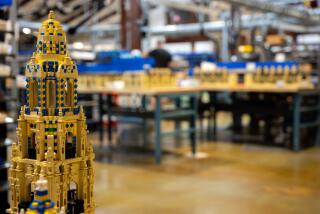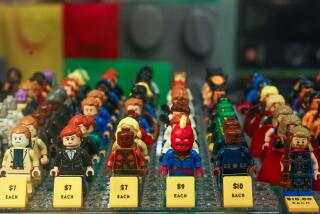International Business : Lego Builds Interest Among Girls, One Pastel-Colored Block at a Time : Marketing: Danish toy maker thinks it’s found post-unisex success with latest line. The secret? Lots of accessories.
- Share via
BILLUND, Denmark — By the end of the 1980s, Lego noticed something was wrong. Girls seemed to be losing interest in the toy maker’s small, colorful, plastic building blocks.
Company executives in this central Danish town scratched their heads. They commissioned inquiries, hired experts, studied child psychology. Finally they learned what may seem obvious to many: Girls and boys are different.
“Girls had become girls again, after the 1970s and the first half of the 1980s unisex period,” said Lars Koelbaek, Lego’s international marketing manager.
To become the world’s fifth-largest toy maker, Lego had based its philosophy on “the good Scandinavian unisex tradition that toys were for boys and girls,” Koelbaek said.
Were the times changing, or was there truth in the cliche that boys play with blocks and girls play with dolls?
The question is crucial for the family-owned company. For the first time since 1949, when it introduced the interlocking bricks now known and copied worldwide, Lego is making a strategic differentiation between the sexes.
In the late 1980s, Lego realized its sales for girls were dropping.
“Lego was such a big success that we didn’t really feel that there was a special need for girls,” Koelbaek said. “Recently, we had to admit that we had a wrong conception of it.”
Lego will not give any figures reflecting the decline. But it had a hunch that the drop meant girls were abandoning the colored bricks earlier in life than boys.
So the company conducted psychological analyses of girls’ behavior, watched them at play, interviewed mothers and commissioned market research worldwide.
Psychologists concluded that girls develop interests other than toys much earlier than boys. Across cultures and national boundaries, they found that girls put down blocks and start trying on clothes, combing their hair, playing roles.
“All toy makers have the same problem. Children turn their backs to toys and get interested in other things when they reach the age of 7 or 8,” said Joergen Klausen, head of marketing at Lego Overseas.
In its studies, Lego also found that pastel colors appeal to girls. Blue, red, yellow, black and green--the traditional basic colors of Lego bricks for decades--catch boys’ attention.
When Lego experimented with dolls, it found that for a girl to identify with the toy, it had to be relatively large, realistic and have flexible joints. Details and lots of accessories were crucial.
The lessons were important for Lego, which tried to target girls in previous years with little success. Its Scala line--small plastic bricks with flowers that could be assembled into necklaces--was a failure and abandoned in 1981 after two years.
The 1979 Fabuland series--small animals dressed like human beings--was meant for both genders. But sales were lackluster through 10 years of effort, spokeswoman Eva Lykkegaard said.
Then in 1992, Lego launched its first girl-friendly pastel-colored bricks, called Paradisa. But girls were turned off by the small, yellow-faced human figures that came with the blocks.
Lego tried again in 1994, unveiling its Belville line. The figures are bigger--3.2 inches--have limbs that bend, and include a family with children and pets, a pastel-colored house, a pony club, a dog kennel and a nursery.
Lykkegaard said Belville sales for its first Christmas season last year were pretty good, though she declined to provide any figures.
So far Belville has been sold only in Europe and the United States. But the toy maker is confident that with this line, it may finally be learning how to keep girls interested.
“We are certain that it will stay on the market,” Lykkegaard said.
Danish carpenter Ole Kirk Kristiansen first produced the company’s wooden toys. The company was called Lego, a contraction of the Danish words for “play well”--”leg godt.”
Lego continued to make wooden toys until a fire destroyed its factory in 1960. The company then switched to making all its bricks from plastic, and the disaster turned out to be a blessing in disguise.
Last year, the Lego Group posted revenue of $1.03 billion, an 8% increase from 1993.
The company’s growth, however, was modest, and it lost ground in Western Europe and North America. Its biggest gains came in Japan and South Korea.
More to Read
Inside the business of entertainment
The Wide Shot brings you news, analysis and insights on everything from streaming wars to production — and what it all means for the future.
You may occasionally receive promotional content from the Los Angeles Times.










